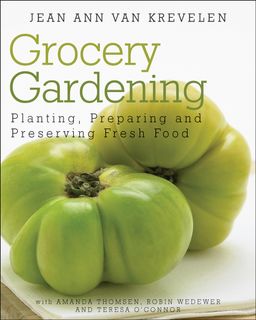 Imagine a world where millions of healthy kitchen gardens are created throughout the nation, for the rich and the poor, because the government makes it the patriotic thing to do.
Imagine a world where millions of healthy kitchen gardens are created throughout the nation, for the rich and the poor, because the government makes it the patriotic thing to do.Is this idea some wild and strange utopian concept? Nope. It's happened before in the United States. In fact, the seeds of this initiative sprouted more than 90 years ago.
To learn more about these old wartime gardens and how they continue to impact our public policy, I turned to Rose Hayden-Smith.
A practicing U.S. historian, Rose is a nationally recognized expert on Victory Gardens, wartime food policies and school garden programs. She's also a 2008-2009 Kellogg Food and Society Policy Fellow, and has long been actively involved in regional and national Master Gardener and 4-H programs. This year, she became the first woman director of Ventura County’s U.C. Cooperative Extension Service.
Recently, Rose sat down with me to give me the dirt on Victory Gardens:
Q: There’s a lot of talk about Victory Gardens these days – especially after the exciting news that a kitchen garden will be built at the White House for the first time since Eleanor Roosevelt. Why were Victory Gardens important to our nation’s history?
A: The Victory Gardens of WWI and WWII provided a way for the government to increase the health and vitality of American citizens.
Victory Gardens reconnected rapidly growing urban populations back to the land, and taught those in the cities how to grow their own food again.
 At the same time, these gardens allowed citizens to express solidarity, patriotism and shared sacrifice during challenging periods in our nation’s history.
At the same time, these gardens allowed citizens to express solidarity, patriotism and shared sacrifice during challenging periods in our nation’s history.
Every socio-economic group grew Victory Gardens. Not just at homes, but at schools, parks, open lots and government buildings too. The campaigns were highly successful.
Q: Sounds interesting. How were the gardens supported?
A: During WWI, a nationalized school garden program was created by the Federal Bureau of Education and funded with War Department monies. The result was the United States School Garden Army – which led millions of students to build gardens at school, at home and in their communities. These young “soldiers of the soil” grew food for the nation.
 Using the power of mass media, the government also launched the highly successful Liberty Garden campaign (later named the Victory Garden campaign after the Armistice). The campaign encouraged Americans of all ages to build gardens. Within two years, nearly 2 million new home food-producing gardens had been created.
Using the power of mass media, the government also launched the highly successful Liberty Garden campaign (later named the Victory Garden campaign after the Armistice). The campaign encouraged Americans of all ages to build gardens. Within two years, nearly 2 million new home food-producing gardens had been created.
These programs were so successful the campaign was reinstated during WWII. Twelve days after the bombing of Pearl Harbor, the government held a National War Garden Defense Conference. This launched a Victory Garden campaign that called upon Americans of all ages to garden for the nation and the world.
By 1943, nearly 40 percent of fresh fruit and vegetables were grown in school, home and community gardens. More food was being exported to troops and starving European allies. And an estimated three-fifths of Americans participated in some type of gardening activity. Even Eleanor Roosevelt had a Victory Garden at the White House.
 Q: What have you found most fascinating in your research?
Q: What have you found most fascinating in your research?
A: The same issues important during WWI are still relevant more than 90 years later. Back then, the government worried about the security and quality of our food sources.
They wondered how to reconnect people (especially children) to the land. And they were looking for inexpensive ways to improve nutritional levels in diets.
Today, we’re still grappling with these issues.
Fortunately, these old Victory Gardens provide us with plenty of lessons learned. Not to mention, several successful historical models that can direct our public policy today.
Q: Why is the Obama garden so important for the nation?
A: The White House is the nation’s first house. So, it sets a wonderful example for our citizens. This kitchen garden will significantly increase public awareness of the benefits of gardening and eating locally.
Incidentally, one of the most active supporters of this garden was Roger Doiron. He’s the founder of Kitchen Gardeners International and a 2008-2009 Kellogg Food and Society Policy Fellow. Roger’s Eat the View campaign is an important grass-roots program that drew national attention to this topic.
Q: Do you expect to see more such gardens nationally?
A: I certainly hope so. I’d love to see more kitchen gardens built on public spaces all over the nation.
I’m particularly excited about the planned USDA People’s Garden. I was honored to attend a forum about this garden in March, along with representatives from the National Gardening Association, Audubon Society, Seed Savers Exchange and other organizations.
The USDA demonstration garden removes 1,250 square feet of unnecessary paved surface. Instead, it transforms this space into a sustainable garden filled with edibles, native plants and progressive conservation and energy-efficiency ideas that citizens can apply to their own homes.
In fact, the USDA hopes to build community gardens at all its facilities worldwide. So, progress is definitely underway.
Q: What can we learn from these historic gardens?
Q: There’s a lot of talk about Victory Gardens these days – especially after the exciting news that a kitchen garden will be built at the White House for the first time since Eleanor Roosevelt. Why were Victory Gardens important to our nation’s history?
A: The Victory Gardens of WWI and WWII provided a way for the government to increase the health and vitality of American citizens.
Victory Gardens reconnected rapidly growing urban populations back to the land, and taught those in the cities how to grow their own food again.
 At the same time, these gardens allowed citizens to express solidarity, patriotism and shared sacrifice during challenging periods in our nation’s history.
At the same time, these gardens allowed citizens to express solidarity, patriotism and shared sacrifice during challenging periods in our nation’s history.Every socio-economic group grew Victory Gardens. Not just at homes, but at schools, parks, open lots and government buildings too. The campaigns were highly successful.
Q: Sounds interesting. How were the gardens supported?
A: During WWI, a nationalized school garden program was created by the Federal Bureau of Education and funded with War Department monies. The result was the United States School Garden Army – which led millions of students to build gardens at school, at home and in their communities. These young “soldiers of the soil” grew food for the nation.
 Using the power of mass media, the government also launched the highly successful Liberty Garden campaign (later named the Victory Garden campaign after the Armistice). The campaign encouraged Americans of all ages to build gardens. Within two years, nearly 2 million new home food-producing gardens had been created.
Using the power of mass media, the government also launched the highly successful Liberty Garden campaign (later named the Victory Garden campaign after the Armistice). The campaign encouraged Americans of all ages to build gardens. Within two years, nearly 2 million new home food-producing gardens had been created.These programs were so successful the campaign was reinstated during WWII. Twelve days after the bombing of Pearl Harbor, the government held a National War Garden Defense Conference. This launched a Victory Garden campaign that called upon Americans of all ages to garden for the nation and the world.
By 1943, nearly 40 percent of fresh fruit and vegetables were grown in school, home and community gardens. More food was being exported to troops and starving European allies. And an estimated three-fifths of Americans participated in some type of gardening activity. Even Eleanor Roosevelt had a Victory Garden at the White House.
 Q: What have you found most fascinating in your research?
Q: What have you found most fascinating in your research?A: The same issues important during WWI are still relevant more than 90 years later. Back then, the government worried about the security and quality of our food sources.
They wondered how to reconnect people (especially children) to the land. And they were looking for inexpensive ways to improve nutritional levels in diets.
Today, we’re still grappling with these issues.
Fortunately, these old Victory Gardens provide us with plenty of lessons learned. Not to mention, several successful historical models that can direct our public policy today.
Q: Why is the Obama garden so important for the nation?
A: The White House is the nation’s first house. So, it sets a wonderful example for our citizens. This kitchen garden will significantly increase public awareness of the benefits of gardening and eating locally.
Incidentally, one of the most active supporters of this garden was Roger Doiron. He’s the founder of Kitchen Gardeners International and a 2008-2009 Kellogg Food and Society Policy Fellow. Roger’s Eat the View campaign is an important grass-roots program that drew national attention to this topic.
Q: Do you expect to see more such gardens nationally?
A: I certainly hope so. I’d love to see more kitchen gardens built on public spaces all over the nation.
I’m particularly excited about the planned USDA People’s Garden. I was honored to attend a forum about this garden in March, along with representatives from the National Gardening Association, Audubon Society, Seed Savers Exchange and other organizations.
The USDA demonstration garden removes 1,250 square feet of unnecessary paved surface. Instead, it transforms this space into a sustainable garden filled with edibles, native plants and progressive conservation and energy-efficiency ideas that citizens can apply to their own homes.
In fact, the USDA hopes to build community gardens at all its facilities worldwide. So, progress is definitely underway.
Q: What can we learn from these historic gardens?
A: Victory Gardens remind us that the United States has created a successful national gardening program before – and we can certainly do it again.
Some say these gardens are a fad. That they can’t contribute much to our culture. Yet, we’ve seen Victory Gardens can provide meaningful food production, when enough people participate. Not to mention, all the other benefits that go along with a program like this.
When you think about it, there aren’t any downsides to encouraging more Americans to garden. There really are only positives.
Some say these gardens are a fad. That they can’t contribute much to our culture. Yet, we’ve seen Victory Gardens can provide meaningful food production, when enough people participate. Not to mention, all the other benefits that go along with a program like this.
When you think about it, there aren’t any downsides to encouraging more Americans to garden. There really are only positives.
 Learn more about Victory Gardens, Rose’s research, public policy models and other related topics at:
Learn more about Victory Gardens, Rose’s research, public policy models and other related topics at:Rose’s VictoryGrower blog
Rose’s VictoryGrower Web site
Roses's VictoryGrower on Twitter












What a wonderful post featuring a real treasure: Rose! Will send a note out on Twitter.
ReplyDeleteHi,
ReplyDeleteI'm having trouble contact Rose via her blog and so I'm wondering if she might see this question here, or if your readers might have an answer. The Franklin Park Coalition (Boston MA) is looking for information on the parks Victory Gardens that were tended by Italian prisoners of World War II. (I'm hoping to convince the Parks Department that present day community gardens have a historical precedent!). Thanks.
aria@littlhous.net
Hi Daria: I'll forward your message on to Rose. Maybe she has some ideas. Thanks for visiting...
ReplyDelete